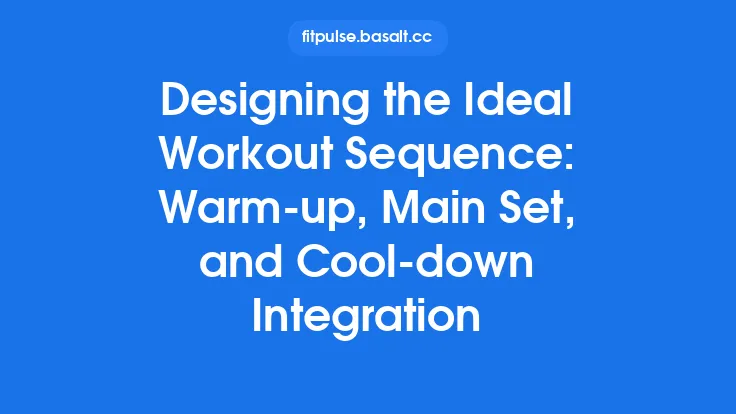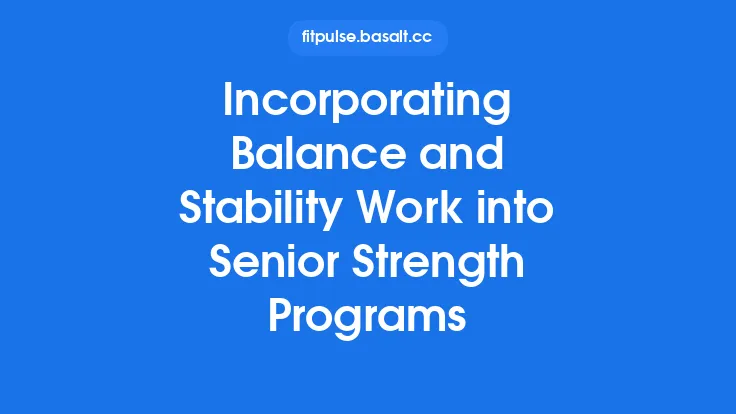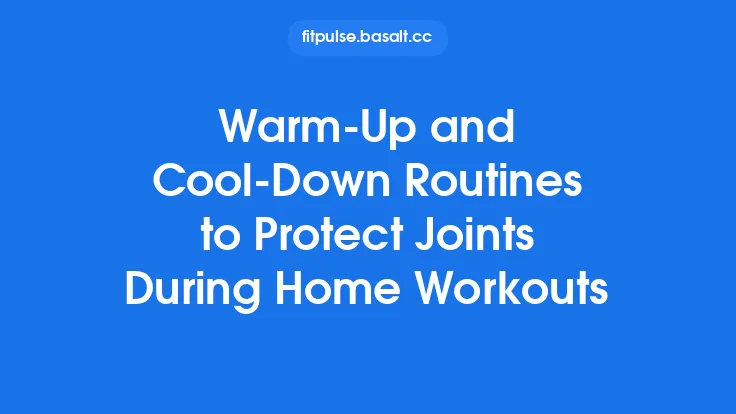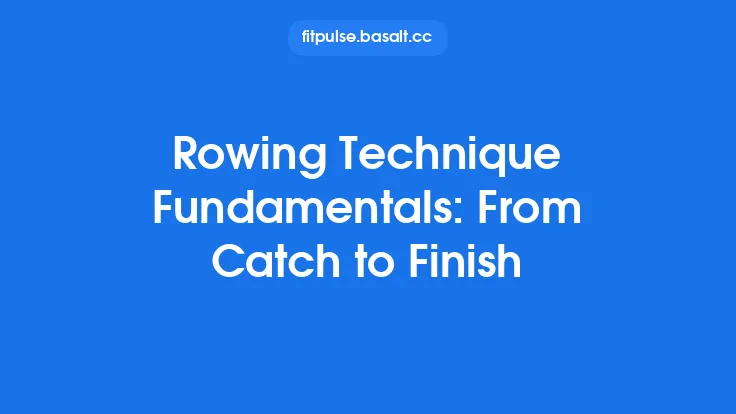Virtual reality has moved beyond novelty and is now a viable platform for delivering comprehensive fitness experiences. Yet, the immersive nature of VR can tempt designers and trainers to focus solely on flashy visuals or high‑octane gameplay, neglecting the fundamental principles that make any workout effective and sustainable. A well‑balanced VR workout program respects the same physiological phases that traditional training does—warm‑up, main effort, and cool‑down—while taking advantage of the medium’s unique ability to cue movement, provide instant feedback, and keep users mentally engaged. Below is a step‑by‑step guide to constructing such programs, with practical considerations for exercise selection, intensity modulation, progression, and recovery, all framed within the constraints and opportunities of a virtual environment.
Understanding the Structure of a Balanced Session
A classic training session can be broken into three physiological blocks:
- Warm‑up (5–10 min) – Elevates core temperature, increases blood flow to working muscles, and primes the nervous system for coordinated movement.
- Main workout (20–40 min) – The primary stimulus for adaptation, where intensity, volume, and specificity are manipulated to achieve strength, endurance, power, or mobility goals.
- Cool‑down (5–10 min) – Facilitates gradual return to baseline, promotes circulation for metabolite clearance, and supports flexibility and relaxation.
In VR, each block can be wrapped in a narrative or visual theme that guides the user seamlessly from one phase to the next. The key is to let the narrative serve the physiology, not replace it. For example, a “mountain trek” warm‑up can consist of low‑intensity steps and arm swings that mimic a gentle ascent, while the main segment might transition to a “summit sprint” with interval bursts, and the cool‑down could become a “sunset stretch” on a virtual plateau.
Designing an Effective Warm‑up for VR
Goals:
- Raise core temperature by 1–2 °C.
- Increase heart rate to 50–60 % of the individual’s maximum (HRmax).
- Activate the motor patterns that will be used later.
Components:
| Component | VR Implementation | Rationale |
|---|---|---|
| Dynamic Mobility | Guided arm circles, hip hinges, and ankle rolls displayed as floating holograms that the user mirrors. | Improves joint range of motion without static holds that can feel “stiff” in a headset. |
| Low‑Intensity Cardio | Light jogging in place or “step‑through” motions across a virtual path, with visual cues (e.g., glowing footprints) to maintain cadence. | Elevates heart rate gradually, reduces the shock of jumping straight into high‑intensity intervals. |
| Neuromuscular Activation | Quick “react‑to‑target” drills where the user reaches for appearing objects, emphasizing hand‑eye coordination. | Engages the central nervous system and primes proprioceptive pathways for later complex movements. |
Timing: Keep the warm‑up under 10 minutes to avoid fatigue. Use a subtle visual timer or auditory cue that fades as the phase ends, signaling the transition without breaking immersion.
Core Workout Design – Selecting Exercises and Modulating Intensity
1. Exercise Selection Aligned with VR Mechanics
| Traditional Modality | VR‑Friendly Equivalent | Key Considerations |
|---|---|---|
| Squat, Lunge, Deadlift | “Power‑push” squat with visual force gauge, “Lunge‑leap” across floating platforms | Ensure the user can maintain proper spine alignment; provide real‑time posture overlay. |
| Push‑up, Chest Press | “Shield‑block” push‑up where a virtual shield appears and must be pressed away | Use hand‑tracking or controllers to detect depth; avoid excessive forward lean. |
| Row, Pull‑up | “Cable‑pull” rowing motion with a virtual rope that tightens as the user pulls | Emphasize scapular retraction cues; limit range to avoid over‑extension. |
| High‑Knee, Jump Rope | “Energy‑burst” sprint where the user taps glowing pads in rhythm | Keep impact low to protect the floor and reduce headset vibration. |
2. Intensity Control Without Over‑Reliance on Metrics
- Perceived Exertion (RPE): Prompt the user every few minutes to rate effort on a 1–10 scale. The program can automatically adjust resistance or speed based on the average rating, keeping intensity within the target zone (e.g., 6–8 for moderate‑to‑hard work).
- Time‑Under‑Tension (TUT): For strength‑focused segments, manipulate the tempo of virtual cues (e.g., “hold for 3 seconds”) to increase muscular time under load without adding external weight.
- Interval Structure: Use classic formats (e.g., 30 s work / 30 s rest) but embed them in story beats—“dodge the meteor” for work, “regenerate shield” for rest—so the user intuitively knows when to push and when to recover.
3. Balancing Volume and Rest
- Set/Rep Schemes: For hypertrophy, aim for 3–4 sets of 8–12 reps per movement, with 60–90 s rest. For endurance, use higher rep ranges (15–20) with shorter rest (30–45 s).
- Circuit Design: Combine 4–6 exercises into a circuit that targets opposing muscle groups, allowing active recovery while maintaining elevated heart rate.
- Progressive Overload: Increase difficulty by (a) adding visual resistance (e.g., thicker virtual ropes), (b) extending the work interval, or (c) reducing rest time, rather than relying on external load.
Incorporating Periodization and Progression in Virtual Environments
Even though VR sessions can feel like a game, the underlying training plan should follow periodization principles to avoid plateaus and overtraining.
- Macrocycle (12–16 weeks): Define a broad goal—e.g., “increase lower‑body power” or “enhance aerobic capacity.” Choose a narrative arc that evolves (e.g., progressing from a forest trek to a mountain summit).
- Mesocycle (3–4 weeks): Break the macrocycle into blocks focusing on specific adaptations:
- Foundation Phase: Emphasize technique, mobility, and low‑intensity cardio.
- Build Phase: Introduce higher intensity intervals, heavier virtual resistance, and complex movement patterns.
- Peak Phase: Short, high‑intensity bursts with minimal rest, simulating competition or “final boss” scenarios.
- Microcycle (Weekly): Schedule 3–5 sessions, alternating focus (e.g., strength‑oriented day, cardio‑oriented day, active recovery day). Use the same virtual world but change the objectives and intensity cues.
- Progression Mechanics:
- Difficulty Levels: Offer “Level 1, 2, 3…” that automatically adjust the parameters mentioned above.
- Skill Unlocks: As users meet performance thresholds (e.g., completing 3 × 10 reps with RPE ≤ 6), new environments or movement challenges become available, reinforcing progression.
By embedding periodization into the story progression, users experience a natural sense of advancement that mirrors traditional training cycles.
Managing Fatigue and Recovery Within a Session
VR can be mentally stimulating, which sometimes masks physical fatigue. To ensure safe and effective recovery:
- Active Rest Cues: During rest intervals, display low‑intensity visual tasks (e.g., “collect floating orbs”) that keep the user moving lightly, promoting blood flow without adding metabolic stress.
- Breathing Prompts: Integrate brief guided breathing sequences (4‑2‑4 pattern) during the cool‑down or between circuits, using visual breath clouds that expand and contract.
- Hydration Reminders: Subtle on‑screen icons can appear at predetermined times, encouraging the user to sip water without breaking immersion.
- Session Length Monitoring: Keep total session time under 60 minutes for most users, especially beginners, to avoid cumulative fatigue that can lead to reduced performance in subsequent workouts.
Cool‑down Strategies Tailored to VR
A proper cool‑down accelerates recovery and reinforces flexibility gains.
- Gradual Heart‑Rate Decline: Transition from high‑intensity movement to slower, rhythmic actions—e.g., “glide down a gentle river” where the user performs slow, wide arm swings and leg extensions. Aim to bring HR down to ≤ 50 % of HRmax over 3–5 minutes.
- Static Stretch Integration: Present virtual “stretch stations” where the user holds a pose (e.g., hamstring stretch) for 20–30 seconds. Use a visual timer that fades as the stretch is held, and provide subtle haptic or auditory feedback when the optimal stretch depth is reached.
- Mindful Closure: End with a brief narrative moment—such as watching a sunrise over the virtual horizon—paired with a guided body‑scan meditation. This helps lower cortisol levels and reinforces the psychological benefits of the session.
Document the cool‑down duration and the stretches performed; this information can be logged for future reference without becoming a primary performance metric.
Leveraging VR Features to Enhance Program Adherence
- Gamified Progression: Use experience points (XP) tied to physiological milestones (e.g., completing a set at target RPE) rather than purely time‑based scores. This aligns reward structures with training quality.
- Social Context (Optional): Allow users to see silhouettes of friends or teammates performing the same warm‑up or cool‑down, fostering a sense of community without requiring competitive leaderboards.
- Environmental Variety: Rotate scenery (forest, desert, underwater) on a weekly basis to prevent monotony, but keep the underlying exercise prescription consistent to maintain training fidelity.
- Feedback Loops: Provide immediate visual cues for posture (e.g., a glowing outline that turns green when the spine is neutral) and for effort (e.g., a pulse that expands with heart‑rate zones). These cues reinforce correct technique and effort without overwhelming the user with data.
Data‑Driven Adjustments Without Over‑Emphasizing Metrics
While VR platforms can capture a wealth of data (heart rate, motion tracking, session duration), the focus should remain on qualitative adjustments:
- Trend Review: Once a week, present a simple summary—“You completed 4 strength sessions, average RPE 6.5, and maintained a steady heart‑rate zone.” This high‑level view informs the trainer or user whether the program is appropriately challenging.
- Adaptive Algorithms: If the system detects a consistent RPE < 4 across multiple sessions, it can suggest a modest increase in virtual resistance or a shift to a higher‑intensity interval. Conversely, repeated RPE > 8 may trigger a recommendation for additional rest or a reduction in work interval length.
- User‑Driven Modifications: Encourage users to log subjective notes (e.g., “felt tight in shoulders”) after each session. These notes can be cross‑referenced with the visual data to fine‑tune exercise selection or movement cues.
By keeping the data narrative simple, the program avoids the pitfall of becoming a “numbers‑driven” experience that detracts from the immersive, enjoyable nature of VR fitness.
Practical Tips for Trainers and Developers
| Role | Actionable Advice |
|---|---|
| Trainer | • Start clients with a “foundational” VR module that emphasizes movement fundamentals before adding complex game mechanics.<br>• Use the RPE scale as the primary intensity gauge; calibrate each user’s HRmax during an initial assessment.<br>• Schedule regular “re‑assessment” weeks where the narrative is paused, and the focus shifts to technique checks. |
| Developer | • Build modular “warm‑up,” “main,” and “cool‑down” assets that can be swapped across different storylines.<br>• Implement a lightweight state machine that tracks session phase, RPE input, and adaptive difficulty flags.<br>• Ensure visual cues are high‑contrast and positioned within comfortable viewing angles to reduce neck strain. |
| Both | • Keep the physical space requirements modest (≈2 × 2 m) and provide on‑screen warnings if the user steps out of bounds.<br>• Test all movement patterns with a diverse sample (different heights, limb lengths) to guarantee that virtual targets are reachable without over‑extension.<br>• Document the program’s progression logic in a clear, shareable format (e.g., PDF or in‑app guide) so users can understand the “why” behind each phase. |
Final Thoughts
Creating a balanced VR workout program is less about showcasing the latest visual effects and more about translating timeless exercise science into an immersive format. By respecting the three physiological pillars—warm‑up, main effort, and cool‑down—while weaving them into compelling virtual narratives, designers can deliver sessions that are both effective and enjoyable. Thoughtful exercise selection, intelligent intensity modulation, structured periodization, and mindful recovery all remain essential, even when the user feels like they are battling dragons or exploring alien worlds. When these elements are harmonized, VR becomes a powerful conduit for sustainable fitness, offering users a safe, engaging, and progressive path toward their health goals.





